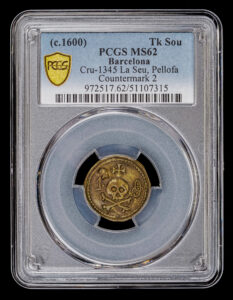
Rare Circa 1600 Cathedral of Barcelona 1 Seu Pellofa – “Memento Mori”
Item #CC-0626 | Rare Circa 1600 Cathedral of Barcelona 1 Seu Pellofa – “Memento Mori”
Mint: Barcelona or Valencia, Spain
Period: Circa 1600
Grade: PCGS MS-62 (Finest and only example graded)
Composition: Brass
For details on this coin from PCGS, click on the serial number here: 51107315
Description: This is a very rare Spanish token known as a “pellofa”, which is the name given to the ecclesiastical tokens used in churches, parishes, brotherhoods and other religious entities in the Catalonia region of North Eastern Spain. This example has a countermark “2” and happens to be the finest and only example graded by PCGS.
The name “pellofa” is derived from the Catalana word “pell” (skin, in Spanish), which is in reference to its thinness as it is made with a very thin planchet, often made of brass, tin, bronze or other metal. The denomination represented by the “1” is known as “La Seu”, which is a Catalana word for “the salary“. Priests and other members of the clergy were paid with these tokens for their attendance at religious services and at the end of each month, they could be exchanged for cash. This was one way the church was able to encourage people to participate in services and other church functions.
Pellofas were used extensively between the 14th and 20th centuries and there are over 1,500 different types in a wide range of shapes and sizes that display unique motifs, including symbols, images or initials of saints, emblems of a cathedral, and denominations. Many of the symbols and images remain a mystery to this day. In the case of this example that bears a skull over crossed bones or “Memento Mori”, it is likely that it was used for funerals.
The process of making pellofas was done in a couple of ways. One was by hammer and die on thin sheets of pre-cut metal, such as bronze or brass. Another way was to pour molten metal into molds where they were cast.
What is the Significance of Memento Mori
In early Christianity, the expression “memento mori” developed with the growth of Christianity, which emphasized divine judgement, heaven, hell, and the salvation of the soul in the afterlife. Memento mori is a Latin phrase, which literally means “Remember death” or “Remember that you die“. The 2nd-century Christian writer Tertullian claimed in his Apologeticus, that during a triumphal procession, a victorious general had someone standing behind him, holding a crown over his head and whispering: “Respice post te. Hominem te esse memento. Memento mori.” Which means “Look after yourself. Remember you’re a man. Remember you will die.”
To the Christian, the prospect of death serves to emphasize the emptiness and fleetingness of earthly pleasures, luxuries, and achievements, and thus also as an invitation to focus one’s thoughts on the prospect of the afterlife. This finds ritual expression in the rites of Ash Wednesday, when ashes are placed upon the worshipers’ foreheads with the words, “Remember man that you are dust and unto dust, you shall return.”
Memento mori is an artistic or symbolic metaphor that serves as a reminder of the inevitability of death and the eternal nature of the human spirit. The most common motif is a skull accompanied by one or more bones. The ‘skull and cross bones’ can be seen on some Roman and early Christian tombs, the Knights Templar used it around the 13th century and pirates used it during the Golden Age of Piracy on their flags known as the “Jolly Roger”.
Sources of Information
The most recognized numismatic book on pellofas is “La Moneda Catalana Local (S. XIII-XVIII)” written by Crusafont i Sabater, published in 1990. A digital copy of his book can be viewed or downloaded for free from The Catalan Society of Numismatic Studies here: https://scen.iec.cat/publicacions/historia-monetaria-catalana/ The PDF can be viewed here as well: https://publicacions.iec.cat/repository/pdf/00000460/00000059.pdf On page 393 of the PDF, you will see an example of this token listed as #1345. For more background and another image of these tokens, visit: http://blog.mac.cat/la-moneda-eclesial-pellofes-i-ploms/
More references and books on pellofas are available at: https://scen.iec.cat/publicacions/historia-monetaria-catalana/
For more information on the history of memento mori style tokens, see our article titled “An In-Depth Look Into Saint Lambert Communion Tokens at https://commodorecoins.com/2023/11/an-in-depth-look-into-saint-lamberts-communion-tokens/

